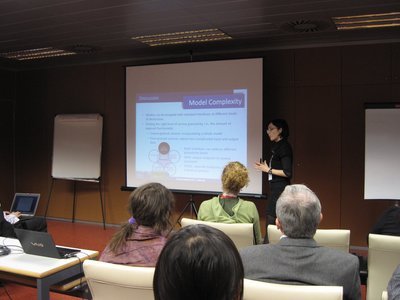EXPLAINABILITY 2024 - The First International Conference on Systems Explainability
November 17, 2024 - November 21, 2024
EXPLAINABILITY 2024: Call for Papers
Onsite and Online Options: In order to accommodate various situations, we are offering the option for either physical presence or virtual participation (pdf slides or pre-recorded videos).
Interpretability, Explainability, and Understandability are characteristics needed for any product, system, device, government regulation, or societal law to increase their trustfulness and acceptability by the end-users. Their role is to avoid bias and increase confidence in the systems’ output.
Explainability favors interpretability and understandability and should be considered during the requirements, design, deployment and maintenance phases of all software, hardware, and complex systems. To a large extent, explainability is present as a user manual, software requirements tracking and code identification, validation/testing results, interactive interfaces, explanation of models, guidelines for industrial robots, and in any human-driven procedural processes. Desiderata on explainability become more complex for Artificial Intelligence (AI)-based entities/systems in terms of 'thinking' via internal mechanisms and accepting/trusting the output.
Explainability is a sought-after property of any complex 'products'. In AI-based systems, the explanation of the behavior of models for certain critical systems is mandatory. This is a complex task, considering that the behavior is the result of intricate development processes involving humans, algorithms, datasets, and other artificial entities (tools).
EXPLAINABILITY inaugurates a series of events dealing with models and metrics to build a documented and provable trust for the developers and users of any kind of system. Explainability helps to validate tracking between system design requirements and current implementation ensuring validation of evolving properties by continuously learning and adapting the original requirements.
We solicit both academic, research, and industrial contributions. We welcome technical papers presenting research and practical results, position papers addressing the pros and cons of specific proposals, such as those being discussed in the standard fora or in industry consortia, survey papers addressing the key problems and solutions on any of the above topics short papers on work in progress, and panel proposals.
Industrial presentations are not subject to the format and content constraints of regular submissions. We expect short and long presentations that express industrial position and status.
Tutorials on specific related topics and panels on challenging areas are encouraged.
The topics suggested by the conference can be discussed in term of concepts, state of the art, research, standards, implementations, running experiments, applications, and industrial case studies. Authors are invited to submit complete unpublished papers, which are not under review in any other conference or journal in the following, but not limited to, topic areas.
All topics and submission formats are open to both research and industry contributions.
EXPLAINABILITY 2024 conference tracks:
Concepts for the foundation of explainability
Explainability requirements
Explainability for a diverse audience
Standards to support a device-agnostic cooperation
Explainability via inclusivity, empathy, and emotion adoption
Post hoc explainability
Design guidelines for explainable interfaces
Causality and explainability
Interpretability and understandability
Procedural vs distributive fairness
Fairness, accountability, and transparency
Interpretability methods (predictive accuracy, descriptive accuracy, and relevancy)
Relation: prediction, accuracy, explainability, and trust
Explainability Models
Transparent models for practitioners and users
Unifying approach for interpreting model predictions
Design guidelines for explainable models
Explainable levels vs prediction accuracy of results
Local explanations to global understanding
Intrinsic explainable models
Trustfulness and acceptability models
Model interpretability
Black-box machine learning models (LIME, SHAP)
Classical Explainability Revisited
Improve Product "User's Manual"
Essentials in Drug explanation side effects
Directory of FAQ (Frequently Asked Questions)
Explanatory buyer's contacts
Adverse analytics of laws and governmental decisions
Observability and in-context interpretability
Explainability via social networks
Explainability via validated reputation metrics
Explainability Classical Tools
Interpretation model of product/software predictions
Key Performance Indicators (KPIs)
Repository of data models
Interpretability models
Explainability for human-in-the-middle systems
Cultural context-sensitive social explainability guidelines
Explainable (personalized) Interfaces
Explainable models for personality
Explainability and social norms
Explainability in personality design
Explainability on emotional interaction
Explainability for tactile and haptic interactions
Explainability for linguistics of personality needs
Explainability for conversational user interfaces (CUIs) (e.g., text-based chatbots and voice-based assistants)
Observable personality
Explainability for impaired users
Explainable Software
Explainability by-design (designer/programmer comments)
Challenges for tracking requirements thru the deployment process
Transparency levels (interface, component, the entire model, learning algorithms)
Screening methods for deviation and bias (data and algorithms)
Black box vs Explainable box
Insights on model failures/performance
Explainability feature for evaluation of software analytics models
Design for approachability
IF-THEN understanding vs scalability
Metrics and metrology for compliance validation with the requirements
Explainability of Data Processing Algorithms
Classification Prediction accuracy vs Explainability
Deep Learning (Neural Networks)
Support Vector Machines
Ensemble Methods (e.g., Random Forests)
Graphical Models (e.g., Bayesian Networks)
Decision Trees, Classification Rules
Convolutive Neural Networks (for images)
Datasets Explainability
Training datasets vs validation datasets selection explainability
Poor explainability from huge data patterns
Methods for pattern explanation
Explainability on validation algorithms and thresholds selection
Explainability on computation power vs performance trade-off
Post hoc on a dataset (in biostatistics data analytics)
Explaining type-specific topic profiles of datasets
Transformers datasets (for natural language processing model)
Explainability of heterogeneous dataset collections
Personalized Datasets (DS) Explainability
Universal vs. cultural personalized datasets
Sensitive social cues to the cultural context
Ramifications of personality
Observable personality
Explainability for impaired users
Explainability in Small Datasets
Explainability between small data and big data
Statistics on small data
Handling small datasets
Predictive modeling methods for small datasets
Small and incomplete datasets
Normality in small datasets
Confidence intervals of small datasets
Causal discovery from small datasets
Dynamic domain-oriented small datasets (health, sentiment, personal behavior, vital metrics, mobility)
Machine Learning (ML) Explainability
Taxonomy for ML Interpretability
ML Interpretability (ML model accuracy for a valid 'from cause to effect')
ML vs machine personality
Explainabiltiy of opacity and non-intuitiveness models
Explainabiltiy for ML models (supervised, unsupervised, reinforcement, constrained, etc.);
Explainability for generative modeling (Gaussian, HMM, GAN, Bayesian networks, autoencoders, etc.)
Explainability of prediction uncertainty (approximation learning, similarity, quasi-similarity)
Training of models (hyperparameter optimization, regularization, optimizers)
Explanability of data types (no data, small data, big data, graph data, time series, sparse data, etc.)
Explainability of hardware-efficient machine learning methods
Methods to enhance fairness in ML models
Deep Learning (DL) Explainability
Explainability for Sentiment Analysis
Active learning (partially labels datasets, faulty labels, semi-supervised)
Details on model training and inference
Data Inference for Small/Big Data
Theoretical models for Small/Big Data
(Integrated) Gradients explanation technique
Deep LIFT (deep neural predictions)
Guided BackPropagation, Deconvolution (Convolution Networks)
Class Activation Maps (CAMs), GradCAM, Layer-wise Relevance Propagation (LRP)
RISE algorithm (prediction of Deep Neural Networks for images)
Explainable AI
Large Language Models (LLM)
Autoregressive language models
Limitation of AI-based analytics agents
Visibility into the AI decision-making process
Explainable AI (feature importance, LIME, SHAP, etc.)
Local Interpretable Model-agnostic Explanations (LIME)
Shapley additive explanations (SHAP) (multiple explanations for different kinds of models)
User role-based and system target-based AI explainability
Explainability at work
Lessons learned for deploying explainable models
Limitation self-awareness
Limitation by design (critical missions)
Controlled machine personality
Setting wrong expectations
Wrong (misleading) explainability models
Pitfalls of explainable ML
Missing needs for various stakeholders
AI/ML/DS/DL Explainability tools
Open-source experimental environments
Matching observability perception vs official explainability
Precision model-agnostic explanations
Criticism for interpretability
Fairness-aware ranking
Conflicting explanations
Additive explanations
Counterfactual explanations
Datasets-based tools (e.g., collection faces reacting to robots making mistakes)
Explainability for emerging artificial intelligent partners (robots, chatbots, driverless car transportation systems, etc.)
Bias detection for diversity and inclusion
Small datasets for benchmarking and testing
Small data toolkits
Data summarization
Explainability case studies
- Lessons learned with existing generative-AI tools (ChatGPT, Bard AI, ChatSonic, etc.)
- Sentiment analysis:
- Explainability DL for sentiment analysis (detection: bias, hate speech, emotions; models)
- Word-embedding and embedding representations
- Lexicon-based explainability for sentiment analysis
- Industry AI explainability
- Predictive maintenance
- Robot-based production lines
- Pre-scheduled renewals of machinery
- Pharmaceutical
- Output explainability for other case studies
- Social networks
- Educational environments
- Healthcare systems
- Scholarly discussions (e.g., peer review process discussions, mailing lists, etc.)
- Mental health systems
- Human fatigue estimation
- Hazard prevention
Deadlines:
Submission | Sep 16, 2024 |
Notification | Oct 10, 2024 |
Registration | Oct 20, 2024 |
Camera ready | Oct 25, 2024 |
Deadlines differ for special tracks. Please consult the conference home page for special tracks Call for Papers (if any).
INSTRUCTION FOR THE AUTHORS
Authors of selected papers will be invited to submit extended versions to one of the IARIA Journals.
Publisher: XPS (Xpert Publishing Services)
Archived: ThinkMindTM Digital Library (free access)
Prints available at Curran Associates, Inc.
How to submit to appropriate indexes.
Only .pdf or .doc files will be accepted for paper submission. All received submissions will be acknowledged via an automated system.
Contribution types
- regular papers [in the proceedings, digital library]
- short papers (work in progress) [in the proceedings, digital library]
- ideas: two pages [in the proceedings, digital library]
- extended abstracts: two pages [in the proceedings, digital library]
- posters: two pages [in the proceedings, digital library]
- posters: slide only [slide-deck posted on www.iaria.org]
- presentations: slide only [slide-deck posted on www.iaria.org]
- demos: two pages [posted on www.iaria.org]
FORMATS
Only .pdf or .doc files will be accepted for paper submission. All received submissions will be acknowledged via an automated system.
Final author manuscripts will be 8.5" x 11", not exceeding 6 pages; max 4 extra pages allowed at additional cost.
Helpful information for paper formatting for MS Word can be found here.
There is a community provided LaTeX template: the CTAN package iaria (with full IARIA formatting rules, including IARIA citation style, but for providing citation style it is tightly bound to pdflatex+biblatex+biber). In addition, there is also iaria-lite (not bound to pdflatex+biblatex+biber, but compatible with any TeX stack; thus, it cannot provide the IARIA citation formattings, but only the titlepage and content-related IARIA formatting rules). Based on the iaria package, there is a minimal working example as Overleaf template. When you are using the LaTeX templates, please still adhere to the additional editorial rules.
Slides-based contributions can use the corporate/university format and style.
Your paper should also comply with the additional editorial rules.
Once you receive the notification of contribution acceptance, you will be provided by the publisher an online author kit with all the steps an author needs to follow to submit the final version. The author kits URL will be included in the letter of acceptance.
We would recommend that you should not use too many extra pages, even if you can afford the extra fees. No more than 2 contributions per event are recommended, as each contribution must be separately registered and paid for. At least one author of each accepted paper must register to ensure that the paper will be included in the conference proceedings and in the digital library, or posted on the www.iaria.org (for slide-based contributions).
CONTRIBUTION TYPE
Regular Papers (up to 6-10 page article -6 pages covered the by regular registration; max 4 extra pages allowed at additional cost- ) (oral presentation)
These contributions could be academic or industrial research, survey, white, implementation-oriented, architecture-oriented, white papers, etc. They will be included in the proceedings, posted in the free-access ThinkMind digital library and sent for indexing. Please submit the contributions following the instructions for the regular submissions using the "Submit a Paper" button and selecting the appropriate contribution type. 12-14 presentation slides are suggested.
Short papers (work in progress) (up to 4 pages long) (oral presentation)
Work-in-progress contributions are welcome. These contributions represent partial achievements of longer-term projects. They could be academic or industrial research, survey, white, implementation-oriented, architecture-oriented, white papers, etc. Please submit the contributions following the instructions for the regular submissions using the "Submit a Paper" button and selecting the contribution type as work in progress. Contributors must follow the conference deadlines, describing early research and novel skeleton ideas in the areas of the conference topics. The work will be published in the conference proceedings, posted in the free-access ThinkMind digital library and sent for indexing. For more details, see the Work in Progress explanation page. 12-14 presentation slides are suggested.
Ideas contributions (2 pages long) (oral presentation)
This category is dedicated to new ideas in their very early stage. Idea contributions are expression of yet to be developed approaches, with pros/cons, not yet consolidated. Ideas contributions are intended for a debate and audience feedback. Please submit the contributions following the instructions for the regular submissions using the "Submit a Paper" button and selecting the contribution type as Idea. Contributors must follow the conference deadlines, describing early research and novel skeleton ideas in the areas of the conference topics. The work will be published in the conference proceedings, posted in the free-access ThinkMind digital library and sent for indexing. For more details, see the Ideas explanation page. 12-14 presentation slides are suggested.
Extended abstracts (2 pages long) (oral presentation)
Extended abstracts summarize a long potential publication with noticeable results. It is intended for sharing yet to be written, or further on intended for a journal publication. Please submit the contributions following the instructions for the regular submissions using the "Submit a Paper" button and selecting the contribution type as Extended abstract. Contributors must follow the conference deadlines, describing early research and novel skeleton ideas in the areas of the conference topics. The work will be published in the conference proceedings, posted in the free-access ThinkMind digital library and sent for indexing. 12-14 presentation slides are suggested.
Posters (paper-based, two pages long) (oral presentation)
Posters are intended for ongoing research projects, concrete realizations, or industrial applications/projects presentations. The poster may be presented during sessions reserved for posters, or mixed with presentation of articles of similar topic. A two-page paper summarizes a presentation intended to be a POSTER. This allows an author to summarize a series of results and expose them via a big number of figures, graphics and tables. Please submit the contributions following the instructions for the regular submissions using the "Submit a Paper" button and selecting the contribution type as Poster Two Pages. Contributors must follow the conference deadlines, describing early research and novel skeleton ideas in the areas of the conference topics. The work will be published in the conference proceedings, posted in the free-access ThinkMind digital library and sent for indexing. 8-10 presentation slides are suggested. Also a big Poster is suitable, used for live discussions with the attendees, in addition to the oral presentation.
Posters (slide-based, only) (oral presentation)
Posters are intended for ongoing research projects, concrete realizations, or industrial applications/projects presentations. The poster may be presented during sessions reserved for posters, or mixed with presentation of articles of similar topic. The slides must have comprehensive comments. This type of contribution only requires a 8-10 slide-deck. Please submit the contributions following the instructions for the regular submissions using the "Submit a Paper" button and selecting the contribution type as Poster (slide-only). The slide-deck will be posted, post-event, on www.iaria.org.
8-10 presentation slides are suggested. Also a big Poster is suitable, used for live discussions with the attendees, additionally to the oral presentation.
Presentations (slide-based, only) (oral presentation)
These contributions represent technical marketing/industrial/business/positioning presentations. This type of contribution only requires a 12-14 slide-deck. Please submit the contributions following the submission instructions by using the "Submit a Paper" button and selecting the contribution type as Presentation (slide-only). The slide-deck will be posted, post-event, on www.iaria.org.
12-14 presentation slides are suggested.
Demos (two pages) [posted on www.iaria.org]
Demos represent special contributions where a tool, an implementation of an application, or a freshly implemented system is presented in its alfa/beta version. It might also be intended for thsoe new application to gather the attendee opinion. A two-page summary for a demo is intended to be. It would be scheduled in special time spots, to ensure a maximum attendance from the participants. Please submit the contributions following the submission instructions by using the "Submit a Paper" button and selecting the contribution type as Demos. The Demos paper will be posted, post-event, on www.iaria.org.
Tutorial proposals
Tutorials provide overviews of current high interest topics. Proposals should be for 2-3 hour long. Proposals must contain the title, the summary of the content, and the biography of the presenter(s). The tutorial slide decks will be posted on the IARIA site.
Please send your proposals to tutorial proposal
Panel proposals
The organizers encourage scientists and industry leaders to organize dedicated panels dealing with controversial and challenging topics and paradigms. Panel moderators are asked to identify their guests and manage that their appropriate talk supports timely reach our deadlines. Moderators must specifically submit an official proposal, indicating their background, panelist names, their affiliation, the topic of the panel, as well as short biographies. The panel slide deck will be posted on the IARIA site.
Please send your proposals to panel proposal

































